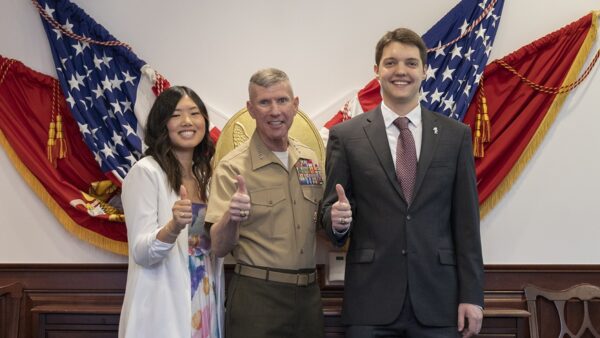Vision 2020: Texas A&M’s Aspirational Document Revisited
In the fall of 1997, Texas A&M University President Ray Bowen initiated Vision 2020 — an aspirational outline designed to elevate the university among its national public peers. As the year 2020 comes to an end, several key participants involved in the comprehensive project reflect on its bold mission and its continuing impact on the university today.
Officials within the diverse group of 250 or so people who spent thousands of hours over two years planning for the next two decades agree that the far-reaching plan contributed greatly to the university, expanding its national and international prominence. A few outcomes born from Vision 2020 include:
- Texas A&M’s induction into the prestigious Association of American Universities (AAU)
- Research expenditures nearing $1 billion annually
- Enrollment growth by almost 40 percent to 71,109
- An escalation in hiring and retaining distinguished professors
- Achieving one of the nation’s largest-ever fundraising campaigns
- Accommodating rapid physical growth with state-of-the-art facilities
- Accelerating national and global reach
The Kitchen Cabinet
The idea behind creating what came to be known as Vision 2020 was the brainchild of Eddie Joe Davis ’67, then-president of The Texas A&M Foundation, who earned his bachelor’s, master’s and Ph.D. from A&M. He held the job of foundation president for 23 years – from 1993-2016 – leaving briefly to serve as interim university president from December 2006 to January 2008.
The foundation’s most recent campaign had ended in 1996 having raised a total of $637 million. Not long after, Davis said he went to Bowen – Texas A&M’s president from June 1994 to July 2002 – and said in order for the foundation to increase the amount raised in the next campaign and continue to elevate the university’s endeavors, Bowen should consider initiating a study.
“I’ve always felt that fundraising is a product of both relationships and an understanding of what people want to connect to,” Davis said. “It is important for them to understand, what are they giving to? What are they trying to achieve?”
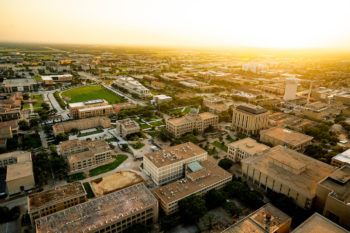
At the time, he said, he wasn’t quite sure what kind of study he was suggesting, except that A&M had a history of having what he described as “intergenerational studies,” referring to the Aspirations Study and Target 2000.
The Aspirations Study was conducted in the early 1960s during the presidency of James Earl Rudder and proposed the end of mandatory service in the Corps of Cadets, called for the full admission of women, and launched the serious development of graduate education. A second major study, Target 2000, was conducted in the 1980s, with its main aspirations to strengthen faculty governance and the university’s computing and international capabilities, and to increase the emphasis on private fundraising. Davis said both studies resulted in the accomplishment of the vast majority of their goals.
“We were living on fumes, so to speak, in terms of the changes that had occurred as a result of those studies,” he said, adding that Bowen agreed and initiated the new, 20-year aspirational study: Vision 2020.
“I thought about it and it made very good sense to me,” Bowen said, reflecting on his decision to move forward with the project. “I talked to members of the board and others, and everybody was enthusiastic about it. And the miracle is that it was so strongly adopted by the A&M community – the faculty, students, staff, former students and the leadership of the state.”
Bowen and Davis were joined in launching the endeavor by Jon L. Hagler ’58, at the time a partner in an investment firm, and Robert W. Harvey ‘77, a management consultant, in what Davis jokingly referred to as “the kitchen cabinet.”
“Much of the early thinking came out of that four-person kitchen cabinet and there were interesting and unique discoveries made there,” Davis said, noting the coincidence that all four men had previously served as either Corps commanders or deputy commanders during their years as Aggie undergraduates.
Hagler recalled being asked by Bowen — his college roommate — to join the effort, saying, “I was thrilled to be asked, and I remember very distinctly the conversation that I had with Ray Bowen. I told him I had only one question — whether this was for show or whether it was for real? And if it was the latter, I’d love to be involved. He assured me it was the latter.”
Dreaming Of An Unpredictable Future
Bowen said looking 20 years into the future was challenging but doable. “We couldn’t really speculate about what the environment would be, but we assumed that the measures of what constitute a great public university would not change fundamentally,” he said.
Davis agreed, saying the notion of a university drafting a strategic plan was nothing new or unique, but what made Vision 2020 different was that it was less about planning and more about aspiring.
“A strategic plan usually looks five to seven years ahead,” he said. “With that type of plan, you’ll have deans who are trying to find more resources; they want to see how to get more money to enhance their programs. To overcome that, we said, ‘Let’s go beyond a period where they can even think about what the resource base may look like.’”
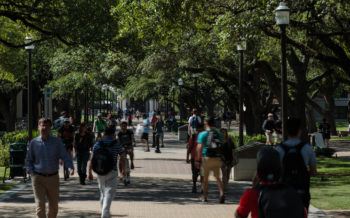
Davis said if you’re looking at the next two decades, it’s hard to make a mistake. “People may say, ‘That’s not possible.’ But if we’re talking over 20 years, actually it might well be possible,” he said.
Mark Weichold, professor of electrical engineering and Texas A&M’s interim provost, served on the Vision 2020 Executive Committee when he was the associate provost for undergraduate programs and academic services.
He was also on the Academic Affairs and Undergraduate Experience Committees. He said there was no way to predict things like the technological advancements that were to come, so those serving on the committees simply committed themselves to excellence, regardless of how “excellence” would be defined two decades later.
“In the late 90s and early 2000s, the internet was there but not nearly as pervasive,” he said. “There were no smart phones or Zoom meetings. I don’t think any of us serving on these committees could have anticipated how ubiquitous these things would become. What guided us through was our commitment to the university, to the faculty and especially to the students, to create excellence – an excellent experience for students in terms of learning and maturation, and for faculty members in their teaching, research and creative endeavors.”
Among the Vision 2020 team’s student members was Will Hurd ’00, the university’s student body president at the time, and now U.S. Congressman for Texas’ 23rd district. He said the study was important because it endeavored to benchmark Texas A&M with other entities.
“It was a forward-looking document to say, ‘Aggies, we’re very prideful in who we are, we think we are the best, but let’s make sure we are doubling down and being the best not only in Texas, but in the rest of the world,’” the former CIA agent said. “Now as a member of Congress who has traveled all over the world, I can say that Texas A&M has a global reputation. And I think a lot of that is because of the hard work that went into developing the Vision 2020 plan.”
The Process
As the project began to unfold, the members of the Vision 2020 effort were divided into 11 theme groups, three white paper panels, and a number of special study groups to identify critical issues and make recommendations. The groups were comprised of faculty, staff, current and former students, and community members.
They were charged with assessing the university’s strengths and weaknesses; defining what attributes determine quality in higher education; comparing Texas A&M to the nation’s best public universities; and determining what would define great universities in the future.
Over the next two years, in hundreds of meetings, the more than 250 people involved spent thousands of hours brainstorming, analyzing data and developing the aspirations that became Vision 2020.

“The imperatives were actionable things we could take on and they have served the university well in guiding us for the past 20 years.”
The Final Report
The commitment to excellence which guided the process is reflected in the final report’s title: Vision 2020: Creating a Culture of Excellence.
The report was formally adopted by the university and the Board of Regents on May 28, 1999.
Hagler said one of the most significant elements of the report was the Board of Regent’s statement upon its approval. “Not only were we able to get the Board on the record as approving the effort, but they included a statement in their approval that the general principles of the report should be a guide for the future direction of the university, and a permanent expression of support for excellence,” he said.
It declared its precepts, focused goals and measures in 12 overarching ideas known as The Twelve Imperatives:
- Elevate faculty and their teaching, research and scholarship
- Strengthen graduate programs
- Enhance the undergraduate academic experience
- Build the letters, arts and sciences core
- Build on the tradition of professional education
- Diversify and globalize the campus community
- Increase access to knowledge resources
- Enrich campus
- Build community and metropolitan connections
- Demand enlightened governance and leadership
- Attain resource parity with the best public universities
- Meet Texas A&M’s land-grant commitment to the state
“The imperatives were actionable things we could take on and they have served the university well in guiding us for the past 20 years,” Weichold said.
Among the report’s many recommendations to achieve The Twelve Imperatives were:
- Continue to recruit the best and brightest students
- Focus on leadership development
- Increase the number of graduate students
- Increase the number of faculty
- Achieve diversity in representation and viewpoints
- Create excellent facilities
- Increase the number of residence halls
- Build high-quality distance education
- Advance educational technology
- Build up humanities and social sciences programs
- Promote campus expertise to national and global media
- Expand and modernize university libraries
- Communicate to legislators and the people of Texas the role that flagship universities play in the state’s economy and general quality of life
- Form new alliances with K-12 schools, corporations and manufacturers
- Broaden opportunities to seek resources
In addition to the main report, Vision 2020 includes The Baseline, a compilation of information about the early stages of the process, and The Groundwork, a compilation of the work of the theme groups, white paper panels and special study groups.
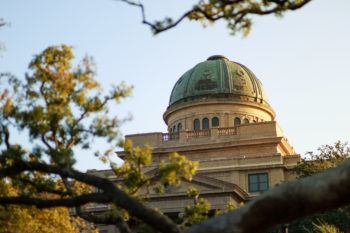
Reaction
Hagler said the report was favorably received by the university community and external constituents, and it came at a good time. “In the first decade of the 2000s, public universities in the state were under enormous pressure,” he said. “The Tea Party movement said universities were luxuries that we couldn’t afford, and that professors made too much money and didn’t do enough.”
This led to some in state government questioning the whole contribution of public universities, Hagler said.
“In that context, the entire Vision 2020 effort was a critical statement of the importance — not just of the A&M community — but to the state and to the nation, and to the idea of democratic countries.”
He said some people might’ve seen the document as too aspirational, but such doubts were quickly dispelled.
“There were some at the outset who thought it was an effort to become ‘Harvard on the Brazos,’” Hagler said. “Closer inspection showed that it was a comprehensive document that told us how A&M could reach its potential. The way in which we approached it, including the combination of the process itself involving so many people both on and off campus, was significant in its success.”
Ellyn Perrone, who served as vice president for governmental affairs at Texas A&M (1999-2002), recalled reading the final report.
“My first impression is that it was a very bold aspirational document,” she said. “It was about what we can be in 20 years and at the same time it was about preserving the heritage and traditions of the university.”
Perrone, the first permanent woman vice president in university history, began at Texas A&M in 1990 as a liaison to legislators and other top officials. Although she wasn’t part of the Vision 2020 team, she said she watched the process unfold and read the report with great interest, impressed by how widely accepted it was by the campus community and beyond.
“It was amazingly accepted without a lot of criticism or pushback,” Perrone said. “It laid out imperatives and goals, with ideas on how to achieve those goals, but it was not a mandate. It left the opportunity down the road for stakeholders to again have input on how we actually navigate through those 20 years.”
John L. Junkins, a professor of aerospace engineering who is set to assume the role of interim university president in January 2021, also was not part of the Vision 2020 planning group, but it came to play a major role for him in creating the Institute for Advanced Studies. He said he was intrigued by the scope of the project and followed its progress after release.
“There were many of us who were asking a fundamental underlying question: ‘Where are the resources coming from to make this vision achievable?’” Junkins said. “Nonetheless, we felt that having a vision that stakes out long-term strategies, if done in pursuit of ambitious goals, will help us find true North when we’re having to make difficult decisions on resource allocation.”
‘Better And Brighter Future’
As the university grew, so did its resources.
“One of the aspirations of Vision 2020 was that we would have two campaigns during those two decades,” Davis said, noting the first campaign, “One Spirit One Vision,” raised $1.5 billion during the first seven years of the new millennium, including funding for 55 endowed faculty chairs, 44 professorships, and over $100 million in graduate fellowships and undergraduate scholarships.
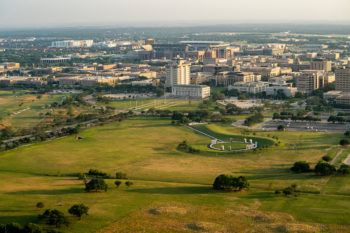
Then in 2015 came “Lead By Example,” one of the largest ever fundraising campaigns in higher education with a goal to raise $4 billion. The campaign is poised to exceed that goal by year-end 2020. “That’s an enormous achievement,” Davis said. “It’s going to be a huge contributor to the welfare of Texas A&M.”
In Fiscal Year 2019, Texas A&M had the seventh-largest endowment of any university in the nation, public or private.
“I think A&M is able to achieve these fundraising goals because it has matured as an institution that understands the relationship between private philanthropy and higher education,” Davis said. “Vision 2020, with its internal and external players, was a big part of getting that change of understanding underway.”
Texas A&M’s eye toward the future is attractive to donors, Davis said.
“Philanthropists want to invest in young people, in research, in change,” he said. “They want to invest in a better and brighter future, which Texas A&M has always been about.”
Mid-Term Review
In fall 2010, then President Bowen Loftin initiated a mid-term review of the university’s progress toward accomplishing the aspirations of Vision 2020.
A task force was assembled to review the previous report, note its successes and make recommendations for the remainder of the period. Similar to Vision 2020, the task force was led by an executive committee and more than 200 faculty, staff, students and external constituents. The groups were divided into 12 study teams, each investigating one of The Twelve Imperatives.
In addition to the “One Spirit One Vision” campaign, the task force listed advancements found to be results of Vision 2020, including membership in Phi Beta Kappa and the AAU, increased enrollment of first-generation and international students, more than $800 million in new facilities, and more.
The report reinforced the importance of The Twelve Imperatives and declared a commitment to continuous improvement, identifying three “Marks of Excellence” to pursue: leading scholarly impact, educating the next generation, and stewardship and partner engagement. The task force made recommendations to achieve these goals known as “Illustrative Actions” and declared the following as “Foundations of Excellence:”
- Development and diversification of financial resources
- Maintenance and enhancement of the institutional infrastructure
- Support and development of staff
- Amplification of faculty excellence
“As an institution, we have accomplished much, but we must not become complacent and allow the challenges of dramatic and complex change to thwart our vision,” the mid-term review concluded. “We should be improving continuously if we are to effectively serve our students, the State of Texas, the nation, and the world.”
A Research Powerhouse
Vision 2020′s founders say the university’s 2001 induction into the AAU solidified its preeminence as a tier-one research university, and it only grew from there: in FY 2000, annual research expenditures were $397.3 million. Today they are nearing $1 billion, and Texas A&M is one of only 65 AAU member universities in the nation.
“You don’t lobby for the AAU. They pick you,” Bowen said. “We knew we were on the short list of universities that might get in. We were thrilled to death about it.”

It was a hard-fought road for the university to become the research powerhouse it is today, said Bowen, who credits John Sharp ’72, chancellor of The Texas A&M University System, for recognizing the importance of research to the success of the university.
“There was a period where we had a public policy organization in Austin which took the position that research at universities is a waste of time and money,” Bowen said. “Some of our regents would openly say the faculty are not teaching enough and research is just duplicating things everybody already knows.”
But in time, he said, different people moved into leadership positions and began to articulate a new set of requirements for the goals of the university.
“We got back on track, and I credit Chancellor Sharp,” Bowen said. “Sharp came out of the political environment and when he came here, he grabbed the idea that research at this university is fundamental.”
One of Sharp’s most notable efforts in support of research was the $100 million Chancellor’s Research Initiative, announced* in 2012, which provided funds to Texas A&M and Prairie View A&M for the recruitment and hiring of faculty members, with particular interest in candidates with success in developing and implementing large, multi-investigator, federally-funded programs. Texas A&M has increased the size of its faculty by several thousand since Vision 2020 was adopted. After the Chancellor’s Research Initiative was announced, the faculty grew from 3,600 to its current count of 4,400.
Weichold said the impact of research at Texas A&M cannot be understated. Thirty-five percent of undergraduates participate in research, gaining invaluable educational experiences. Faculty researchers are able to build their careers and contribute to their fields. And society at large gains from the innovations and problem-solving that research brings.
“We are competitive nationally and internationally in research and these creative activities are central to the student experience,” Weichold said. “We want the very best faculty we can find teaching our students and we’re only going to get the best faculty if we provide research and creative outlets for them. And I think we’ve been singularly successful in doing that.”
One initiative the Vision 2020 founders agreed has bolstered the university’s already stellar research reputation, and hits all 12 imperatives, is the 2010 addition of the Hagler Institute for Advanced Study. Founded and directed by Junkins, the institute brings renowned faculty from all over the nation and world to study and conduct research beside Texas A&M researchers and students.
“I met Jon Hagler in the immediate wake of Vision 2020 and I’ve been acquainted with him ever since,” Junkins recalled. “When we created the institute, one of the most important things I did early on was form an advisory board, and that included Jon Hagler. This board was important because annually, I would give them a ‘report card,’ grading how the institute was developing and stating its ambitions.”
With that context, Junkins said, he never had to ask for money – the institute’s growing reputation inspired Hagler to write a $20 million check. “That’s my kind of fundraising,” Junkins said, “that you put out a commanding idea and work hard to pursue it, and someone says, ‘Yes, this is something I want to invest in.'”
Hagler recalled being very confident in Junkins’ ability to launch the institute.
“He was really well liked and admired in the professorial academic community at Texas A&M,” Hagler said. “He read the report carefully and recognized that at its core, it was addressing the academic quality of A&M and he imagined that it would be extraordinarily helpful if there were a more specific mechanism to deal with the issue of academic quality.”
Junkins had a background where he’d come across other advanced study institutes, Hagler said, particularly at Princeton and the University of Virginia. “He thought it through and figured out how such an institute might be adapted to work at Texas A&M.”
Now a decade later, the institute is thriving, Hagler said, recently having welcomed its ninth class of fellows.
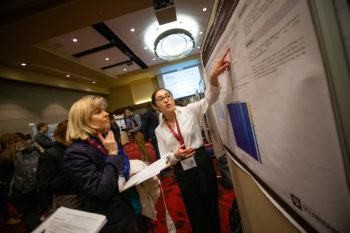
More Goals Met And Continuing Work
As the Vision 2020 team predicted, the university grew in student population: In 2019, it was the nation’s largest with 69,465 students enrolled. And despite the COVID-19 pandemic, this fall enrollment increased by 2.4 percent to 71,109.
Additional sites outside of the College Station flagship that have helped facilitate such growth are Health Science Center locations across the state, the School of Law in Fort Worth, branch campuses in Galveston and Doha, Qatar, and The Higher Education Center at McAllen. Additional study and research centers in Costa Rica, Italy and Mexico, a robust study abroad program (No. 1 public/No. 2 overall for five years running) and continuing matriculation of international students are all contributing to the Vision 2020 imperative to diversify and globalize the university, Weichold said.
And it’s not just about adding students, he said, it’s about adding high-quality students who will become leaders in their field. He pointed to Texas A&M’s repeated No. 1 ranking in Texas in the recruitment of National Merit Scholars, as well as a continuous focus on leadership development through 1,100+ student organizations, the Corps of Cadets, research and capstone projects, and more.
One of Vision 2020’s goals – to build the liberal arts – has seen marked progress. Along with the Colleges of Engineering and Agriculture, the College of Liberal Arts often leads in the number of students it graduates each year.
“When you look at the Glasscock Center, the digital humanities, and the new humanities building, these are all things that are traceable to Vision 2020’s emphasis on developing the humanities,” Junkins said.
Weichold agreed, crediting the College of Liberal Arts for its “incredible creativity,” and noting as examples strong programs in archeology, and research breakthroughs originating from the Center for the Study of the First Americans.
The call in Vision 2020 for increased diversity on campus has been met with the 2010 Diversity Plan, periodic reviews including the latest 2020 State of Diversity Report, and the continuing work of the Office for Diversity with the support of campus-wide committees and college/unit diversity councils. Annual Diversity Accountability Reports submitted by campus entities help monitor and advance the university’s efforts in diversity, inclusion, accountability and equity. The 2019 and 2020 HEED award and Diversity Champion wins from INSIGHT into Diversity magazine are a testament to such efforts, said Junkins, as is the growing Hispanic student population.
“Remarkably we’ve more than doubled the fractional percentage of Hispanic undergraduates, we’re at almost 25 percent,” Junkins said. “This is excellent progress we’ve made to better reflect the demographics of the state. An area of emphasis going forward has to be to attract more African-American students and faculty.”
Achieving top 10 status in the U.S. News and World Report rankings is also a goal moving forward, Junkins said. The ranking was one of the goals of Vision 2020 that has not yet been achieved, but Junkins said the foundation is in place for this to occur, and it’s important to remember that other schools must be displaced in order for Texas A&M to attain the ranking.
“We have indeed arrived at top 10 stature by many measures but in the reputational spectrum, when you have institutions that have been there for a long time, you have to be good for a while to displace those institutions,” he said. “But in terms of impact we are already there.”
The move into the top 10 will be heavily dependent upon students, Weichold said. “Our students are educated beyond the classroom – whether they realize it or not – they’re learning leadership skills as an integral part of Texas A&M education and when they graduate, our expectation is that they are going to be leaders in their field and that’s what will help move us into the top 10.”
The Student Success Initiative, created in 2018, has already made an impact with its focus on innovative student support, first-year and first-generation programs, and improving retention and graduation rates. Since its launch, the retention rate for first-time, first-year students has risen by 2.7 percent to 94.4 percent, and the four-year graduation rate has risen by 5.6 percent to 60.6 percent.
Continuing to recruit outstanding faculty is also key, Weichold said.
“These faculty not only bring their reputation, but in many cases, they develop their reputation here,” he said. “We have incredible creativity and outstanding research across the university. We have faculty members who are bringing us national and international recognition. If we continue on this trajectory, we will achieve that top 10 goal.”
Junkins points to state-of-the-art facilities such as the Zachry Engineering Education Complex and the Innovative Learning Classroom Building as key to attracting and retaining the world’s best students, as well as high-quality, research-focused faculty.
“This is especially true for engineering, sciences and other change-driven disciplines where technology is moving very fast,” Junkins said. “You come to this place where you see these state-of-the art investments and look at the research portfolio of the university and you know, it’s not just about buildings and facilities. This place is really on the move.”

Hagler said the report worked to cultivate the seeds of searching for excellence that others before, especially Rudder, had planted. “I think it’s critical that we elevated the standard of how we’re doing nationally versus a regional perspective,” he said. “These visions for excellence have endured well through the stresses and strains, and the different administrations.”
But, Hagler said, balancing quantity and quality will be a challenge moving forward. “I am absolutely supportive of the notion that we need to serve the state, but we now have 70,000 students, and we’ve doubled the size of engineering, and those present formidable challenges to the maintenance of quality.”
Hagler noted the Washington Monthly ranking, which has repeatedly recognized Texas A&M as a top university for contribution to the public good, is worthy of looking into more carefully. “It’s an effort that judges output as well as input for public research universities,” he said. “It focuses on social mobility, research and promoting public service. It’s closer to the original land-grant mission of what a university adds to society. These are important contributions.”
The Next Vision
A few months ago, the Office of the Provost released Decade of Excellence: The Vision 2020-2030. The aspirational document identifies four strategic pillars:
- The University as Community – a commitment to enrich the learning and working environment for all students, faculty and staff, placing value on diverse perspectives, talents and identities.
- Transformational Education – premier programs and transformative experiences inside and outside of the classroom, melding technology with strong teaching, and developing graduates with innovative approaches to problem-solving
- Discovery and Innovation – continuing to invest in creative people and cutting-edge tools to support their research and scholarship, and
- Impact on the State, Nation and World – maintaining focus on higher education’s vital role in contributing to society through purpose-driven research and groundbreaking discoveries to demonstrate the university’s impact on the world around it.
Accompanying this aspirational document is the 2020-2025 Strategic Plan which is “centered around increasing our global impact; positioning Texas A&M University as a best place to work, live, and learn; growing and supporting faculty, staff, and research; and enhancing and reinventing education for students.”
Weichold said the current five-year strategic plan “aligns perfectly” with The Twelve Imperatives, will build upon Vision 2020’s successes and work to fill gaps where needed.
Hurd, who opted not to seek reelection in 2020, said Texas A&M is poised to play a role nationally and internationally in critical areas.
“One of the things I spent a lot of time on as a member of Congress and as an undercover officer for the CIA is recognizing that we have several generation-defining challenges that our country has faced, and one of those is global leadership and advanced technology,” he said. “Texas A&M is poised to play an important role not only in doing groundbreaking research, but also developing the young men and women who will lead in areas like artificial intelligence and quantum computing.
“The kind of growth we’ve seen from the Vision 2020 plan – I want to see that continue into 2040 and 2060.”
A Campus Changed, Yet Much The Same
Davis said when he walks the campus today, the physical change is remarkable, “but the attitudes haven’t changed,” he said. “The students are still friendly, they’ll stop and say, ‘Can I help you find something?’”

He said the ability for the university to maintain its traditions while advancing its academic and research missions is a tremendous attribute.
Bowen described the generational pride in the university as astounding, emphasizing the essential and meaningful role played by former students. With each era, there’s the delight in “modern day A&M and the prospect of the future A&M being even better.”
“Former students are proud that we’ve maintained our core values and traditions as we hire great faculty, recruit great students and make significant research contributions,” Bowen said. “The situation at A&M is a consequence of our unique history and the resulting culture that has evolved over the years. Few would have thought a university that has experienced the massive changes as we have over the past 60 or so years would have improved as we have done, while – at the same time – retained pride in our history.”
* This link is no longer active and has been removed.
Media contact: Kelly Brown, kelly.brown@tamu.edu

